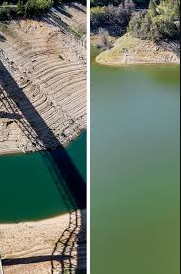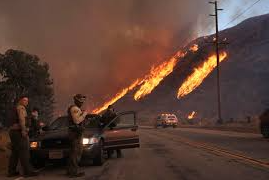
Record rainfall and snowstorms end the state’s severe drought, but flooding risks remain.
An extraordinary series of storms has dramatically reversed California’s severe drought, replenishing the state’s reservoirs with record levels of rain and snow. Just months ago, key reservoirs faced dangerously low water levels, with scenes of cracked, dry land where boat docks once stood, and cars driving through what should have been a submerged Folsom Lake. But now, thanks to a series of powerful atmospheric rivers, 12 of California’s 17 major reservoirs are filled beyond their historical averages for the spring.
Notable among these are Folsom Lake and Lake Oroville, the latter housing the tallest dam in the U.S. This marks a remarkable recovery from late last year when nearly all of California was in drought, including regions suffering from extreme conditions. Farmers left fields fallow, wells ran dry, and cities imposed strict watering restrictions. But since December, the state has experienced the opposite extreme, with up to 700 inches of snow in the Sierra Nevada, and the driest years on record quickly giving way to the wettest weeks in history.
The sudden shift from drought to surplus has had a significant hydrological impact, with Karla Nemeth, director of the California Department of Water Resources, noting that the state is no longer in a drought, aside from some small regions. However, the new challenge lies in managing the floodwaters. Some reservoirs are so full that water is being released to make room for storm runoff and snowmelt, which could cause flooding in the spring and summer, especially in the Sierra foothills and Central Valley.
The snowpack in the Sierra Nevada is now one of the largest on record, with its water content at 239% of the usual average, which could lead to dangerous snowmelt flooding. Water managers are already releasing water from Oroville Dam, which had to undergo repairs after a 2017 failure, to manage this potential overflow.
In stark contrast to 2021, when Lake Oroville’s water levels had dropped so low that its hydroelectric dam ceased operating, the lake’s water levels now stand 230 feet higher, making recreational activities more accessible. With reservoirs across the state holding abundant water, Governor Gavin Newsom has lifted some water restrictions, but he has yet to declare the drought officially over, particularly in areas still dependent on the struggling Colorado River.
The surge in water supplies is expected to benefit cities and farms across California, but state officials warn that this could be a temporary relief. Climate change means the state could face future cycles of severe drought, and residents must continue to use water efficiently. Nemeth emphasised the importance of adopting conservation practices, stating that while one wet year has helped, dry conditions are likely to return with even greater intensity.










